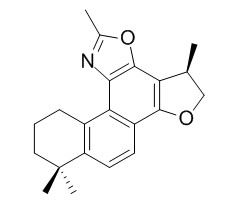Salvianan
Salviane exhibits the most potent cytotoxicity with a CD50 range of 30.4-39.5 microM against HeLa (cervical epitheloid carcinoma), HepG2 (hepatocellular carcinoma), and OVCAR-3 (ovarian adenocarcinoma) cell lines in a dose-dependent manner.
Inquire / Order:
manager@chemfaces.com
Technical Inquiries:
service@chemfaces.com
Tel:
+86-27-84237783
Fax:
+86-27-84254680
Address:
1 Building, No. 83, CheCheng Rd., Wuhan Economic and Technological Development Zone, Wuhan, Hubei 430056, PRC
Providing storage is as stated on the product vial and the vial is kept tightly sealed, the product can be stored for up to
24 months(2-8C).
Wherever possible, you should prepare and use solutions on the same day. However, if you need to make up stock solutions in advance, we recommend that you store the solution as aliquots in tightly sealed vials at -20C. Generally, these will be useable for up to two weeks. Before use, and prior to opening the vial we recommend that you allow your product to equilibrate to room temperature for at least 1 hour.
Need more advice on solubility, usage and handling? Please email to: service@chemfaces.com
The packaging of the product may have turned upside down during transportation, resulting in the natural compounds adhering to the neck or cap of the vial. take the vial out of its packaging and gently shake to let the compounds fall to the bottom of the vial. for liquid products, centrifuge at 200-500 RPM to gather the liquid at the bottom of the vial. try to avoid loss or contamination during handling.
Phytomedicine.2023, 114:154813.
J.Acta Agriculturae Scandinavica2017, 571-575
Cells. 2023, 12(15):1934.
Plant Sci.2020, 301:110656.
Dental Journal2024, 57(4): 254-258
Herbal Formula Science2024, 32(2):155-179.
J Pharm Biomed Anal.2018, 151:32-41
Curr Issues Mol Biol.2023, ;45(2):1601-1612.
Comput Biol Med.2024, 178:108775.
J Ethnopharmacol.2022, 282:114574.
Related and Featured Products
J Nat Prod. 2005 Jul;68(7):1066-70.
Nitrogen-containing compounds from Salvia miltiorrhiza.[Pubmed:
16038550]
METHODS AND RESULTS:
Five new N-containing compounds, neosalvianen (1), salvianen (2), Salvianan (3), salviadione (4), and 5-(methoxymethyl)-1H-pyrrole-2-carbaldehyde (5), were isolated from Salvia miltiorrhiza.
Their structures were mainly established by spectroscopic methods. Neosalvianen (1) and its analogues (6a, 6b) were synthesized for spectroscopic data comparison. Compounds 1, 2, 4, and 6a were evaluated for their cytotoxic activities against selected cancer cell lines. Among these components, salvianen (2) exhibited the most potent cytotoxicity with a CD50 range of 30.4-39.5 microM against HeLa (cervical epitheloid carcinoma), HepG2 (hepatocellular carcinoma), and OVCAR-3 (ovarian adenocarcinoma) cell lines in a dose-dependent manner.
CONCLUSIONS:
The cytotoxicities of the tested compounds were not specific and showed similar activities to the selected cancer cell lines.



